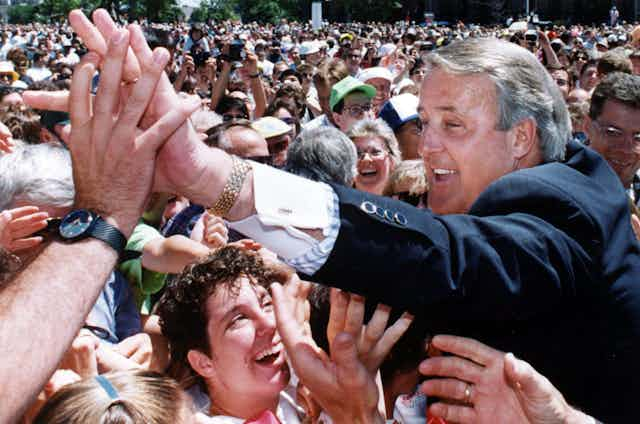Brian Mulroney — Canada’s 18th prime minister who has died at age 84 — will be remembered for many things, but his most significant decision during two terms in office was to link Canada’s future with the United States.
Unlike Pierre Trudeau, Canada’s Liberal prime minister who had a rocky relationship with several U.S. presidents during the 1960s, ‘70s and '80s, Mulroney was an unabashed Americanophile.
After all, he grew up in Baie-Comeau, Que., a town founded by a wealthy American industrialist — Robert Rutherford McCormick — to produce cheap newsprint for New York and Chicago papers. Mulroney would at times reminisce that as a child he sang songs for McCormick to earn small monetary rewards.
Negotiated Free Trade Agreement
Mulroney’s admiration for American capitalism was evident in his political polices. Within a year after being elected with a large majority in 1984, Mulroney stated he wanted to negotiate a free trade agreement with the United States.

Shortly after that, Mulroney hosted then U.S. president Ronald Reagan for what was called the “Shamrock Summit” in Québec City. The two leaders, both of whom were proud of their Irish heritage, took to the stage at the summit and famously launched into a rendition of When Irish Eyes Are Smiling.
While some Canadians may have cringed at the sight of the two men warbling together, Mulroney’s close relationship with Reagan was a political asset for the Progressive Conservative leader.
A second majority
Mulroney and Reagan signed the U.S.-Canada Free Trade Agreement on Jan. 2, 1988. Mulroney campaigned on the deal during Canada’s general election in November of that year and won a second consecutive majority. Some international media outlets dubbed Mulroney “the Father of North American Free Trade” in stories about his death.

The Mulroney years marked the end of a two-decade reign by the Liberals under Lester Pearson, Trudeau and John Turner. Mulroney shifted Canadian policy to the right when he negotiated the Free Trade Agreement. Other controversial policies — the privatization of Crown corporations like Air Canada and Petro-Canada, and the introduction of the goods and services tax (GST) — would last and not be undone when the Liberals returned to power under Jean Chrétien in 1993.
Mulroney, more than any modern day prime minister, sought to atone for the actions of his predecessor Trudeau in constitutional reform.
Investing enormous political capital in the Meech Lake Accord and then the Charlottetown Accord, Mulroney tried to increase the jurisdiction of the provinces, reform the Senate and recognize Québec as a distinct society. He wanted to extensively change the Constitution and correct what was not done, or in his view done poorly, in the patriation of the Constitution in 1982 and the introduction of the Charter of Rights and Freedoms.
Constitutional reforms failed
After pitched battles across the nation, both accords failed to meet the constitutional bar for ratification. In fact, the collapse of the accords — which had raised expectations in Québec — revived Québec separatism and led to the rise of the Bloc Québécois.
The failure of the accords was a lesson subsequent prime ministers — Chrétien, Stephen Harper and Justin Trudeau — took to heart. None has dared to even hint at any kind of constitutional reform.
When in power, Mulroney led the Progressive Conservatives. After retirement from politics, Mulroney never felt at home at the renamed Conservative Party of Canada that was born with the merger of the Progressive Conservative Party and the Canadian Alliance in 2003.

During one of his last major public events in June 2023, Mulroney sat on stage with Justin Trudeau at St. Francis Xavier University, the Nova Scotia institution from which Mulroney graduated. Mulroney praised the incumbent to such an extent that Trudeau said: “It’s… embarrassing when you’re speaking about me in such glowing terms.”
Mulroney leaves a perplexing legacy. A charismatic politician who led his party to two majority governments. A prime minister who made major and lasting changes to Canada’s economy. A successful business leader before and after his years in politics.
Yet, he was also a prime minister who failed to bring in constitutional reforms that seemed within his grasp and a leader who unleashed political turmoil in his home province that has had a lasting impact on the Canadian political landscape decades after he left office.


